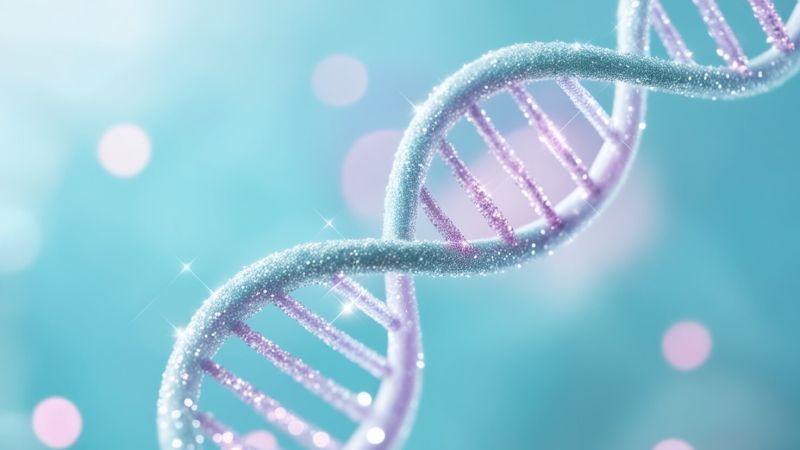
What Are Sirtuins and What Is Their Role in Aging?
Aging is inevitable, influenced by genetics, lifestyle, and the environment. At the cellular level, changes like DNA damage, reduced energy production, and rising inflammation drive aging. The good news is, science has uncovered some fascinating ways to understand and possibly slow down the process.
Among the most exciting discoveries involves sirtuins, a family of proteins that help how our bodies handle aging. They regulate metabolism, protect DNA, and manage oxidative stress to keep our cells functioning properly.
What makes sirtuins particularly intriguing is their connection to NAD+, a molecule that’s critical for their function. Unfortunately, NAD+ levels drop as we get older, limiting sirtuins’ ability to protect our cells from damage.
However, research shows that boosting NAD+ levels through supplements, exercise, and other strategies can reactivate sirtuins to help combat age-related decline. This makes understanding sirtuins an important piece in the puzzle of aging and optimizing health.
In this article, we’ll discuss:
- Why NAD+ is a cofactor for sirtuins and how boosting NAD+ levels can increase sirtuin activity and combat aging.
- The fascinating role of sirtuins in regulating metabolism, DNA repair, and cellular stress, and how they contribute to longevity.
- The science behind caloric restriction and how it activates sirtuins to improve lifespan and overall health.
What are Sirtuins?

Sirtuins are a family of seven evolutionarily conserved proteins (SIRT1-7) that act as cellular regulators, earning them the nickname “guardians of the genome” for their multifaceted roles in metabolism, gene expression, and cellular health. They depend on a molecule called nicotinamide adenine dinucleotide (NAD+) to do their job and carry out molecular functions.
Specifically, sirtuins belong to a family of NAD+-dependent enzymes called histone deacetylases,1 which modify both DNA-packaging proteins and many other cellular proteins. Through their deacetylation activity – removing acetyl groups – sirtuins function as molecular switches that control gene expression, metabolism, stress responses, and cellular aging by responding to the cell’s energy state.
The discovery of sirtuins is rooted in the study of aging. Scientists first identified a sirtuin protein in yeast, called Sir2,2 while investigating the genetic factors that influence lifespan. They found that under conditions of caloric restriction, Sir2 activity increased, leading to a 30%–40% increase in lifespan.3 This discovery sparked interest in sirtuins and their potential role in longevity.
Sirtuins act as important energy status sensors and regulators of metabolism. They respond to changes in cellular energy levels, particularly through their sensitivity to NAD+ levels, which fluctuate based on the nutritional state of the cell.
Sirtuins help control metabolic flexibility, or how your body switches between burning carbohydrates and fats:
- Carbohydrate metabolism: When you’re not eating, sirtuins (specifically SIRT1) help regulate blood sugar in two phases. Initially, they reduce sugar production, but during longer fasting periods, they activate genes that help maintain stable blood sugar levels.4
- Lipid metabolism: Sirtuins also help your body use stored fat for energy when food is scarce. They do this by turning on genes that break down fat while turning off ones that store it.
This flexibility is important for adapting to times of limited food intake or intense physical activity, such as during workouts.
One of sirtuins’ most important functions is maintaining genome stability through DNA repair mechanisms.5 When cells encounter DNA damage from environmental stressors like UV radiation, pollution, or normal metabolic processes, sirtuins help coordinate the repair response. SIRT1 and SIRT6, in particular, are instrumental in recruiting DNA repair proteins and modifying chromatin structure to facilitate repair processes.
Every day, your cells encounter DNA damage from things like pollution or even normal cellular processes. Sirtuins also help repair this damage, preserving the integrity of your genetic material.6 Without this function, cells accumulate errors, leading to aging and age-related diseases.
Beyond DNA repair, sirtuins contribute significantly to cellular stress resistance through multiple pathways.7 They activate antioxidant defense systems to combat oxidative stress, regulate mitochondrial function to maintain energy balance, and modulate inflammatory responses.
When sirtuins are active, they help your body adapt to challenges, repair itself, and function more efficiently. But as we age, factors like declining NAD+ levels reduce their effectiveness. This decline leads to many age-related issues, including slower metabolism, reduced cellular repair, and increased inflammation.
Key Takeaway: Sirtuins are NAD+-dependent proteins that act as cellular regulators, managing metabolism, DNA repair, and aging processes by functioning as molecular switches that respond to cellular energy states and help maintain genomic stability.
The Sirtuin Family: Characteristics and Functions
The sirtuin family consists of seven unique proteins, SIRT1 through SIRT7. Each sirtuin has its own job to keep your body functioning optimally and protect it from the effects of aging and disease. Let’s see what makes each of these proteins so important.
| Sirtuin | Location | Major Functions | Disease Associations |
| SIRT1 | Nucleus, Cytoplasm | Metabolism regulation Stress response DNA repair Cell survival Circadian rhythm control | Type 2 diabetes, cardiovascular disease, neurodegenerative disorders, cancer |
| SIRT2 | Cytoplasm, Nucleus | Cell cycle regulation Microtubule dynamics Glucose metabolism Inflammation control | Neurodegenerative diseases, cancer, insulin resistance |
| SIRT3 | Mitochondria | Mitochondrial energy metabolism ROS regulation Fatty acid oxidation ATP production | Age-related hearing loss, metabolic syndrome, cancer, cardiac hypertrophy |
| SIRT4 | Mitochondria | Amino acid metabolism Fatty acid oxidation Insulin secretion ATP homeostasis | Type 2 diabetes, cancer, metabolic disorders |
| SIRT5 | Mitochondria | Urea cycle Cellular respiration Ketone body formation ROS management | Cancer, metabolic disorders, cardiovascular disease |
| SIRT6 | Nucleus | DNA repair Telomere maintenance Glucose homeostasis Inflammation regulation | Aging, cancer, type 2 diabetes, cardiovascular disease |
| SIRT7 | Nucleolus | rRNA transcription Chromatin remodeling Stress response Lipid metabolism | Cancer, cardiovascular disease, aging |
SIRT1 and SIRT3: The MVPs

Among the sirtuin family, SIRT1 and SIRT3 stand out as the real power players.8 They are key to many processes that keep your body running efficiently and aging gracefully.
SIRT1 takes the lead in regulating metabolism9 and the stress response. It helps the body adapt to changes in energy availability, like during fasting or exercise, by activating pathways that promote fat-burning and energy conservation. It also manages inflammation and protects cells from oxidative damage, a common contributor to aging and chronic diseases.
What’s particularly fascinating is how SIRT1 also modulates circadian rhythms10—those 24-hour biological cycles that govern so many of our physiological processes. This circadian connection has significant implications for metabolic homeostasis, helping explain why SIRT1 dysfunction is often linked to metabolic disorders like type 2 diabetes, which are more common as we age.
If SIRT1 governs metabolism, SIRT3 is the guardian of mitochondria, those remarkable cellular organelles that power virtually every biological process in our bodies. SIRT3 optimizes mitochondrial function by regulating energy production,11 controlling reactive oxygen species (ROS), and boosting antioxidant defenses. This intricate balancing act is critical because when ROS production exceeds our antioxidant capacity, the resulting oxidative stress can trigger a cascade of cellular damage that contributes to accelerated aging.
SIRT3 also supports fatty acid oxidation,12 a process where fats are broken down for energy. It also helps preserve heart health and hearing as we age. Its protective effects on mitochondria are especially critical for organs with high energy demands, like the brain and heart.13
As shown in our table above, SIRT1 and SIRT3 operate in different cellular compartments (SIRT1 in the nucleus and cytoplasm, and SIRT3 in the mitochondria), but they both protect your body from the effects of aging and disease. Both help guard against neurodegenerative diseases and reduce the risk of heart-related conditions.
Key Takeaway: SIRT1 and SIRT3 protect against aging by regulating metabolism and maintaining cellular energy production in different parts of the cell.
Sirtuins and NAD+

Our understanding of sirtuins and aging comes with a critical caveat – these cellular guardians are only as effective as their fuel supply.
Sirtuins require NAD+ as an essential co-substrate to perform their deacetylation functions, and the steep decline in NAD+ levels as we age – up to 50%14 – directly impairs sirtuin activity across all seven family members. This diminishing NAD+ availability helps explain why cellular repair, metabolic efficiency, and inflammation control tend to worsen over time.
Interestingly, you can support sirtuin function by replenishing NAD+ levels.15 NAD+ precursors, such as nicotinamide riboside (NR) and nicotinamide mononucleotide (NMN), are supplements that help restore NAD+ in the body. With their support for NAD+, these precursors effectively reactivate sirtuins, enabling them to continue protecting your cells and promoting overall health.
Sirtuins and the Aging Process

The relationship between sirtuins and aging represents one of the most fascinating areas of longevity research. As we age, our bodies experience various forms of cellular decline, from decreased energy production to accumulating DNA damage. Sirtuins contribute in either preventing or repairing these age-related changes, earning their reputation as longevity proteins.
At the molecular level, sirtuins influence aging through several key mechanisms. They help maintain genomic stability by coordinating DNA repair processes and managing chromosomal structure, with SIRT6 specifically helping to maintain telomeres16 – the protective caps at our chromosomes that naturally shorten as we age. Additionally, sirtuins regulate inflammation through multiple pathways,17 helping combat “inflammaging,” the chronic, low-grade inflammation that contributes to various age-related diseases like Alzheimer’s and dementia.
Perhaps most importantly, sirtuins influence how our cells produce and use energy. They optimize mitochondrial function, helping these cellular powerhouses produce energy more efficiently while generating fewer harmful byproducts. This is particularly significant because mitochondrial dysfunction is a hallmark of aging, contributing to everything from muscle weakness to cognitive decline.
The decline in NAD+ levels particularly affects sirtuin function, creating a vicious cycle where reduced sirtuin activity accelerates various aspects of aging, which in turn further impairs sirtuin function. This understanding has led to growing interest in interventions that can maintain or boost sirtuin activity with age, from NAD+ supplementation and sirtuin activators to exercise, opening exciting possibilities for promoting healthier aging through targeted interventions.
Key Takeaway: Sirtuins are master regulators of the aging process, choreographing cellular health through multiple pathways that directly influence longevity – from DNA repair and inflammation control to energy metabolism optimization and mitochondrial function.
Sirtuins and Caloric Restriction

Caloric restriction (CR) or reducing your calorie intake without depriving yourself of vital nutrients18 does more than just help with weight management. It activates sirtuins, making them central to the health benefits associated with eating less.
When you practice caloric restriction, your body switches into a survival mode that activates the AMPK pathway, a key energy regulator.19 This process increases NAD+ levels, which, in turn, boosts sirtuin activity. With more active sirtuins, your body becomes better equipped to repair cellular damage, manage stress, and maintain metabolic balance.
CR has been studied for over 60 years and is the only intervention proven to increase the maximum lifespan in mammals. A study published in the Sage Journals showed that even when CR is started later in life, it still can help extend lifespan.20
Research shows that caloric restriction helps extend lifespan and improve healthspan, and sirtuins help in making this happen. They mediate many of CR’s benefits, such as reducing inflammation, protecting against oxidative stress, and improving energy efficiency in cells.
How to Activate Sirtuins

Sirtuin activation doesn’t require a complete lifestyle overhaul. Small, intentional changes can get these cellular protectors working optimally. Many of these changes also improve your overall health and energy levels.
Regular exercise is one of the simplest and most powerful ways to activate sirtuins. A study published in the International Journal of Molecular Sciences found that physical activity increases NAD+ levels and triggers pathways that improve sirtuin function, especially SIRT1 and SIRT3.21 Even brisk walking stimulates these proteins,22 promoting better metabolism, reduced oxidative stress, and improved cellular repair.
Certain natural compounds, like resveratrol, can directly activate sirtuins.23 Found in foods like red grapes, blueberries, and peanuts, resveratrol mimics the effects of caloric restriction by enhancing SIRT1 activity. While you’d need a lot of these foods to notice benefits, high-quality resveratrol supplements offer a more practical option.
Since sirtuins rely on NAD+ to function, boosting your NAD+ levels is also a surefire way to increase their activity. NAD+ precursors, like NMN and NR, provide the building blocks for your body to produce more NAD+. These supplements can help maintain optimal sirtuin function as you age.
For those seeking a comprehensive solution to optimize their NAD+ levels and support sirtuin activation, Vitality ↑® NAD+ Booster offers a clinically validated formulation that combines key NAD+ precursors with synergistic ingredients. This advanced supplement pairs NMN and nicotinamide with D-ribose and creatine monohydrate to enhance cellular NAD+ production and support optimal sirtuin function.
The unique combination has shown superior efficacy compared to individual NAD+ precursors alone, making it an evidence-based choice for individuals looking to support their cellular health and potentially reduce age-related decline through enhanced sirtuin activation.
The Road Ahead for Sirtuins

As our understanding of sirtuins expands, recent breakthroughs are transforming the field. Scientists have developed next-generation sirtuin activating compounds (STACs) that are up to 10 times more potent than resveratrol, with compounds like SRT1460 showing remarkable selectivity in targeting specific sirtuins.24 Meanwhile, research has unveiled sirtuins’ complex role in cancer biology25 and their potential as diagnostic biomarkers, with SIRT3 and SIRT7 showing particular promise in detecting systemic diseases.26
While supplements and targeted interventions show increasing promise, lifestyle factors like exercise, nutrition, and stress management remain fundamental to optimal sirtuin function. The broad influence of sirtuins – spanning DNA repair, metabolism, and cellular health – makes them crucial targets for promoting healthier aging.
The story of sirtuins reminds us that aging isn’t simply a passive process but one that can be understood and influenced. Through continued research and practical applications, we’re uncovering new ways to support these cellular guardians and potentially extend our healthspan for generations to come.
Referenced Sources:
- https://www.nature.com/articles/s41392-022-01257-8 ↩︎
- https://pmc.ncbi.nlm.nih.gov/articles/PMC4101544/ ↩︎
- https://journals.plos.org/plosbiology/article? ↩︎
- https://www.ijbs.com/v07p0575.htm ↩︎
- https://febs.onlinelibrary.wiley.com/doi/10.1111/febs.13053 ↩︎
- https://febs.onlinelibrary.wiley.com/doi/10.1111/febs.13053 ↩︎
- https://www.aging-us.com/article/100544/text ↩︎
- https://pmc.ncbi.nlm.nih.gov/articles/PMC3746174/ ↩︎
- https://pmc.ncbi.nlm.nih.gov/articles/PMC3527007/ ↩︎
- https://link.springer.com/article/10.1007/s00018-020-03713-6 ↩︎
- https://www.frontiersin.org/journals/cellular-neuroscience/articles/ ↩︎
- https://pmc.ncbi.nlm.nih.gov/articles/PMC2841477/ ↩︎
- https://atm.amegroups.org/article/view/20070/19964 ↩︎
- https://atm.amegroups.org/article/view/20070/19964 ↩︎
- https://www.liebertpub.com/doi/10.1089/ars.2017.7258 ↩︎
- https://www.nature.com/articles/s41598-018-23602-0 ↩︎
- https://www.sciencedirect.com/science/article/abs/pii/S1359610117301740 ↩︎
- https://www.nia.nih.gov/news/calorie-restriction-and-fasting-diets-what-do-we-know ↩︎
- https://www.frontiersin.org/journals/physiology/articles/ ↩︎
- https://www.frontiersin.org/journals/physiology/articles/ ↩︎
- https://www.mdpi.com/1422-0067/20/11/2717 ↩︎
- https://pmc.ncbi.nlm.nih.gov/articles/PMC10643563/ ↩︎
- https://www.sciencedirect.com/ ↩︎
- https://www.mdpi.com/1420-3049/29/5/1185 ↩︎
- https://www.frontiersin.org/journals/oncology/articles/ ↩︎
- https://erar.springeropen.com/articles/10.1186/s43166-024-00266-5 ↩︎
Read More














